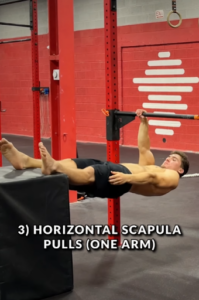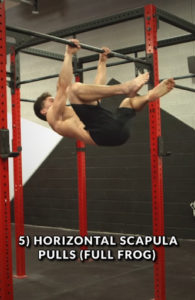Ever feel a twinge in your shoulder during a workout or struggle with stiff shoulders that just won’t loosen up? If so, you are not alone; it is estimated that up to 70% of people will suffer from shoulder pain at some point.
The shoulders are one of the most injury-prone areas in the body, especially for those who love pushing their limits in the gym. But here’s the thing—those aches and pains aren’t inevitable. With the right exercises, you can build shoulders that are strong, mobile, and resistant to injury.
In this guide, we’re diving into the top exercises to help you bulletproof your shoulders so you can move freely, lift confidently, and keep injuries at bay. Let’s get started!
✨Understanding Shoulder Anatomy and Function
Before we dive into the exercises, let’s take a quick look at what’s going on under the hood. Your shoulder is a ball-and-socket joint, giving it a wide range of motion. This flexibility is great for movement but can also make the shoulder joint more vulnerable to instability and injury.
The muscles surrounding your shoulder—the rotator cuff, deltoids, trapezius, and the muscles around your scapula—play a massive role in keeping your shoulders stable and mobile. When these muscles are strong and flexible, your shoulder is better protected against injury and can perform at its best.
🎯Warm-Up Routine: Preparing Your Shoulders for Exercise
Before you can truly bulletproof your shoulders, it’s crucial to lay the foundation with a thorough and targeted warm-up. Think of your warm-up as the protective layer that shields your shoulders from injury and primes them for strength-building exercises.
When we talk about bulletproofing your shoulders, we’re talking about creating a resilient shoulder girdle that can withstand the demands of intense workouts while staying injury-free. And that process starts right here with a proper warm-up.
-
✅ Start with gentle arm circles.
Arm circles are more than just a way to get the blood flowing; they’re vital in mobilizing your shoulder joints and preparing them for the work ahead. You gently ease your shoulders into motion by starting with small, controlled circles and gradually increasing their size.
This careful preparation is essential to bulletproofing your shoulders because it ensures that your joints are ready to handle the load of more challenging exercises. Arm circles activate the muscles surrounding your shoulder joint, including the deltoids and rotator cuff, setting the stage for enhanced stability and mobility.
-
✅ Incorporate dynamic shoulder stretches.
Dynamic stretching is where you start addressing one of the bulletproof shoulders’ key components—mobility. Exercises like the cross-body shoulder stretch and the doorway stretch target the often tight and neglected areas around your shoulders.
By incorporating these dynamic stretches, you’re not only warming up the muscles but also actively improving your shoulder flexibility. Mobility helps your shoulders move through their full range of motion, preventing injuries and ensuring they can handle your workout without damage.
-
✅ Activate the rotator cuff with specific movements.
A bulletproof shoulder isn’t just about strength; it’s also about stability. The rotator cuff stabilizes your shoulder joint; activating these muscles before your workout can make all the difference.
Internal and external rotations with a resistance band are targeted movements that wake up these stabilizing muscles, ensuring they’re ready to support your shoulder through the most demanding exercises. This activation step is crucial in building shoulders that are not only strong but also resilient against the common injuries that can derail your progress.
-
✅ Finish with shoulder blade activation.
The muscles around your shoulder blades (scapula) are the unsung heroes of a bulletproof shoulder. They provide the foundation upon which shoulder stability and strength are built.
Scapular retractions activate the rhomboids and trapezius muscles, ensuring that your shoulder blades are properly aligned and stable. This stability enables you to perform exercises with proper form and control, lowering your risk of injury while increasing your overall shoulder strength. Focusing on these muscles during your warm-up takes a critical step toward bulletproofing your shoulders.
💯5 Top Exercises for Bulletproof Shoulders
Now that you’re warmed up let’s move on to the good stuff—the exercises that will help you build strong, stable, and injury-resistant shoulders.
1. 👊Scapular Rotations
Let’s start with scapular rotations. Scapular rotations are fundamental exercises that enhance shoulder mobility and maintain joint health. This movement is particularly beneficial for preventing stiffness and improving the range of motion in the shoulder joint.
Whether looking to rehabilitate an injury or simply maintain flexibility, scapular rotations help keep the scapulae moving fluidly, which is crucial for overall shoulder function. Regular practice can reduce the risk of shoulder impingement and other related injuries.
How to:
- Stand tall and hold onto a pole or stable surface for support.
- Retract your shoulder blades, then move your shoulder forward, up, back, and down in a circular motion.
- After completing the rotations in one direction, reverse by moving your shoulder back, up, forward, and down.
- Keep movements smooth and controlled.
- Do 10-15 rotations in each direction.
2. 👊Scapula Pinches
Next up, scapula pinches! Scapula pinches are vital for strengthening the upper back muscles, particularly the rhomboids and middle trapezius. These muscles retract the shoulder blades, which helps to maintain good posture.
In today’s world, where many spend long hours in front of screens, scapula pinches help counteract poor posture and reduce the risk of shoulder and neck pain. This exercise also contributes to better shoulder alignment, essential for injury prevention.
How to:
- Rest your arms at your sides as you stand or sit.
- Draw your shoulder blades together, as if pinching a pencil between them.
- Hold the pinch for 2-3 seconds.
- Ensure your shoulders are relaxed, not shrugged, and your neck is not strained.
- Gradually release and return to the starting position.
- Repeat for 10-15 reps.
- Focus on controlled movements and engaging the upper back muscles.
3. 👊Horizontal Scapula Pulls (One Arm)
Ready for a challenge? Try horizontal scapula pulls with one arm. Horizontal scapula pulls with one arm target the stabilizing muscles around the shoulder girdle, which are crucial for controlling shoulder movements and providing stability.
This exercise is particularly effective for addressing imbalances between the shoulders, which can improve overall strength and coordination. Focusing on scapular stability can enhance your control over shoulder movements, reduce the risk of injury, and develop a stronger mind-muscle connection.
How to:
- Lie under a bar with your feet elevated on a box. Grip the bar with one hand.
- Tighten your core, retract your scapula, and pull your upper body slightly off the ground.
- Keep your body straight from head to heels. Your free arm stays by your side.
- Slowly lower yourself back down, focusing on smooth movement.
- Do 8–12 reps, then switch sides.
4. 👊Scapula Pulls
If you’re working on your pull-ups, scapula pulls are a must. Scapula pulls are essential for those looking to improve their pull-up technique. This exercise isolates the initial movement of a pull-up, which involves engaging the scapula.
Strengthening this movement lays the foundation for efficient and powerful pull-ups, reducing the risk of compensatory movements that can lead to injury. Additionally, scapula pulls strengthen the muscles around the shoulder blade, promoting overall shoulder health and functionality.
How to:
- Hang from a pull-up bar with your arms extended and grip shoulder-width apart.
- Without bending your elbows, engage your shoulder blades by pulling them down and together.
- Lift your body slightly upward with the engagement of your scapula.
- Hold the position for a moment.
- Lower yourself back to the starting position with control.
- Aim for 8–12 reps.
- Focus on maintaining scapular engagement throughout the movement.
5. 👊Horizontal Scapula Pulls (Full Frog)
Finally, let’s discuss horizontal scapula pulls in the full frog position. Horizontal scapula pulls in the full frog position are advanced exercises that challenge shoulder stabilizers and core strength. This movement requires coordination and strength, making it ideal for improving shoulder stability and overall body control.
The full frog position adds difficulty by requiring you to stabilize your hips and engage your core while performing scapular retraction. This exercise is excellent for building shoulder and core strength, which is essential for dynamic and explosive movements.
How to:
- Grip the bar with hands slightly wider than shoulder-width apart.
- Bring your legs up, knees bent outward, and feet close together.
- Tighten your core and retract your shoulders.
- Retract your shoulder blades, lifting your upper body slightly.
- Keep your hips stable and your core engaged throughout.
- Gradually return to the starting position.
- Do 8–10 reps with smooth, controlled movements.
Related article: Elevate Your Training: The Art of Scapula Pull Exercise
🔥Progression Tips: Advancing Your Shoulder Strength
Once you’ve established a solid foundation with the basic exercises, it’s time to push your shoulder strength to the next level. Progression is essential for continued gains, preventing plateaus, and keeping your workouts challenging and engaging.
However, advancing your shoulder training requires a strategic approach to building strength while maintaining proper form and avoiding injury. Here’s how to do it effectively:
1. ⚡️Gradual Intensity Increase
As your shoulders become more robust, the same exercises that once felt challenging may start to feel too easy. This is a good sign that it’s time to up the ante. One way to increase intensity is by adding resistance. For example, you can incorporate resistance bands into your scapula pulls or horizontal scapula pulls. Resistance bands provide extra tension, forcing your muscles to work harder, increasing strength gains.
Another way to progress is by increasing the duration of your isometric holds, such as scapula pinches. Start by holding the pinch for a few seconds longer each session. This extended time under tension challenges your muscles to maintain stability and strength for longer, further enhancing your endurance and control.
2. ⚡️Adding Repetitions and Sets
Once you’ve mastered the primary rep ranges, consider gradually increasing the repetitions or sets you perform. This progression method is particularly effective for exercises like scapular rotations or scapula pinches.
However, it’s important to strike a balance between quantity and quality. Adding too many reps too quickly can lead to fatigue, often resulting in poor form—a major contributor to injuries. A good rule of thumb is to increase your reps or sets by no more than 10–20% each week, allowing your body time to adapt.
3. ⚡️Incorporating Advanced Variations
As you continue to build strength, integrating advanced variations of the exercises can provide a new level of challenge. For instance, try the full frog position variation once you’re comfortable with standard horizontal scapula pulls.
This advanced move increases the demand on your shoulder muscles and engages your core, adding an extra layer of difficulty. Similarly, you can experiment with one-arm variations to focus on unilateral strength, which helps correct any imbalances between your shoulders.
4. ⚡️Prioritizing Form Over Volume
While it may be tempting to push yourself by increasing the weight or reps, maintaining proper form is the most critical aspect of any progression. Poor form reduces the effectiveness of the exercise and increases your chances of injury. If you notice that your form starts to break down—such as your shoulders hunching up towards your ears or your back arching excessively—it’s a sign that you need to scale back.
Focus on executing each movement precisely, even if it means doing fewer reps or reducing the resistance. Remember, consistent quality movements yield better long-term results than sporadic bursts of poor technique.
5. ⚡️Tracking Your Progress
To ensure your progress stays on track, it’s crucial to log your workouts, including reps, sets, and resistance levels. The Movement Athlete app makes this easy by tracking your real-time performance and providing personalized insights.
As you improve, the app adapts your training plan to keep your workouts challenging and effective. Visual progress tracking and customized routines help you stay motivated and avoid plateaus.
If you’re serious about taking your fitness to the next level, try the free personalized assessment offered by The Movement Athlete app. It’s a great way to kickstart your smarter, more adaptive training journey.
🚫Common Mistakes to Avoid
Despite your best efforts, mistakes can slow you down or injure you. Let’s break down some common pitfalls and how to avoid them:
1. ❌Shoulder Hunching
One of the most common mistakes people make during shoulder exercises is letting their shoulders hunch up towards their ears. Shoulder hunching can cause unnecessary neck and shoulder tension, reducing exercise effectiveness and increasing the risk of strain.
To avoid this, keep your shoulders down and back during the movement. Imagine keeping your shoulder blades tucked into your back pockets—this cue can help maintain the proper position and reduce the risk of hunching.
2. ❌Rushing Through Movements
Another common mistake is rushing through exercises to complete more reps or finish the workout faster. Speeding through movements often leads to sloppy form and reduces your muscles’ time under tension, which is crucial for building strength.
Instead, take your time with each rep, focusing on the quality of the movement. Slow, controlled motions ensure that you’re engaging the correct muscles and help you build endurance and improve muscle memory.
3. ❌Neglecting Core and Leg Engagement
Your shoulders don’t work in isolation. Exercises like scapula pulls or horizontal scapula pulls also rely on your core and legs for stabilization. Failing to engage these supporting muscles can lead to poor form and reduce the overall effectiveness of the exercise.
Make a conscious effort to tighten your core and keep your legs active during shoulder exercises. This full-body engagement enhances your performance and helps distribute the workload, reducing the risk of overloading your shoulders.
Integrating 💪Shoulder Exercises into Your Routine
Consistency is vital to building bulletproof shoulders. Aim to perform these exercises 2-3 times a week, independently or as part of your upper-body workout. You can combine them with other upper-body exercises, like push-ups or rows, for a balanced routine. Here’s a sample workout plan:
- Warm-up: Arm circles, shoulder stretches
- Main workout: Scapular rotations, scapula pinches, horizontal scapula pulls (one arm), scapula pulls, and horizontal scapula pulls (full frog).
- Cool down: Shoulder stretches, deep breathing.
This routine will help you build shoulder strength, improve mobility, and prevent injuries.
🧐Frequently Asked Questions
🔎 How often should I do shoulder exercises to keep them bulletproof?
Aim to incorporate shoulder-specific exercises into your routine 2-3 times weekly to maintain strong and healthy shoulders. Consistency is critical, so even dedicating a short time to these exercises can significantly improve shoulder strength and mobility.
🔎 Can I still bulletproof my shoulders if I’ve had a previous injury?
Yes, you can still work on bulletproofing your shoulders, even if you’ve had a previous injury. However, it’s crucial to start slowly and focus on proper form. Begin with low-intensity exercises to rebuild strength and mobility, and gradually progress as your shoulders become stronger. Consult a doctor or physical therapist before starting a new exercise program, especially after an injury.
🔎 What are the essential exercises for bulletproofing my shoulders?
Some of the most effective exercises for bulletproofing your shoulders include scapular rotations, scapula pinches, horizontal scapula pulls (standard and one-arm variations), and scapula pulls. These exercises target the muscles around your shoulder blades, essential for stability and mobility.
🔎 How can I tell if I’m doing shoulder exercises correctly?
Proper form is essential for practical shoulder exercises. Critical signs of the correct form include keeping your shoulders down and back (avoiding hunching), maintaining a neutral spine, and moving through the exercises slowly. If unsure about your form, consider working with a trainer or recording yourself to check your technique.
💥Conclusion
There you have it—the secret to bulletproof shoulders is all about consistent, targeted training combined with smart recovery. By incorporating these exercises into your routine, you’ll build strong, stable shoulders that are resistant to injury and capable of handling whatever challenges your fitness journey throws.
So keep rotating, pinching, and pulling your way to healthier, stronger shoulders. You’ll feel the difference not just in your workouts but in your overall movement and posture.
Ready to take your shoulder health to the next level? Sign up for a free, personalized assessment with The Movement Athlete. Get tailored advice and a custom training plan to enhance mobility, prevent injuries, and build rock-solid strength. Start your journey to bulletproof shoulders today!







